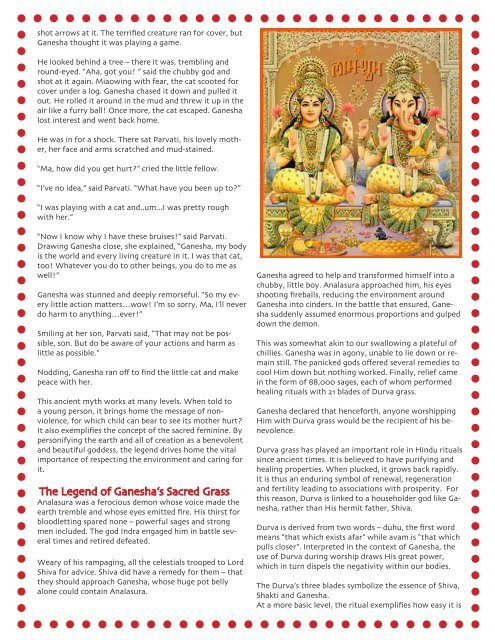Ganesh Chaturti - Shree Nath Dham
Ganesh Chaturti - Shree Nath Dham
Ganesh Chaturti - Shree Nath Dham
Create successful ePaper yourself
Turn your PDF publications into a flip-book with our unique Google optimized e-Paper software.
shot arrows at it. The terrified creature ran for cover, but<br />
<strong>Ganesh</strong>a thought it was playing a game.<br />
He looked behind a tree – there it was, trembling and<br />
round-eyed. “Aha, got you! ” said the chubby god and<br />
shot at it again. Miaowing with fear, the cat scooted for<br />
cover under a log. <strong>Ganesh</strong>a chased it down and pulled it<br />
out. He rolled it around in the mud and threw it up in the<br />
air like a furry ball! Once more, the cat escaped. <strong>Ganesh</strong>a<br />
lost interest and went back home.<br />
He was in for a shock. There sat Parvati, his lovely mother,<br />
her face and arms scratched and mud-stained.<br />
“Ma, how did you get hurt?” cried the little fellow.<br />
“I’ve no idea,” said Parvati. “What have you been up to?”<br />
“I was playing with a cat and..um...I was pretty rough<br />
with her.”<br />
“Now I know why I have these bruises!” said Parvati.<br />
Drawing <strong>Ganesh</strong>a close, she explained, “<strong>Ganesh</strong>a, my body<br />
is the world and every living creature in it. I was that cat,<br />
too! Whatever you do to other beings, you do to me as<br />
well!”<br />
<strong>Ganesh</strong>a was stunned and deeply remorseful. “So my every<br />
little action matters…wow! I’m so sorry, Ma, I’ll never<br />
do harm to anything…ever!”<br />
Smiling at her son, Parvati said, “That may not be possible,<br />
son. But do be aware of your actions and harm as<br />
little as possible.”<br />
Nodding, <strong>Ganesh</strong>a ran off to find the little cat and make<br />
peace with her.<br />
This ancient myth works at many levels. When told to<br />
a young person, it brings home the message of nonviolence,<br />
for which child can bear to see its mother hurt?<br />
It also exemplifies the concept of the sacred feminine. By<br />
personifying the earth and all of creation as a benevolent<br />
and beautiful goddess, the legend drives home the vital<br />
importance of respecting the environment and caring for<br />
it.<br />
The Legend of <strong>Ganesh</strong>a’s Sacred Grass<br />
Analasura was a ferocious demon whose voice made the<br />
earth tremble and whose eyes emitted fire. His thirst for<br />
bloodletting spared none – powerful sages and strong<br />
men included. The god Indra engaged him in battle several<br />
times and retired defeated.<br />
Weary of his rampaging, all the celestials trooped to Lord<br />
Shiva for advice. Shiva did have a remedy for them – that<br />
they should approach <strong>Ganesh</strong>a, whose huge pot belly<br />
alone could contain Analasura.<br />
<strong>Ganesh</strong>a agreed to help and transformed himself into a<br />
chubby, little boy. Analasura approached him, his eyes<br />
shooting fireballs, reducing the environment around<br />
<strong>Ganesh</strong>a into cinders. In the battle that ensured, <strong>Ganesh</strong>a<br />
suddenly assumed enormous proportions and gulped<br />
down the demon.<br />
This was somewhat akin to our swallowing a plateful of<br />
chillies. <strong>Ganesh</strong>a was in agony, unable to lie down or remain<br />
still. The panicked gods offered several remedies to<br />
cool Him down but nothing worked. Finally, relief came<br />
in the form of 88,000 sages, each of whom performed<br />
healing rituals with 21 blades of Durva grass.<br />
<strong>Ganesh</strong>a declared that henceforth, anyone worshipping<br />
Him with Durva grass would be the recipient of his benevolence.<br />
Durva grass has played an important role in Hindu rituals<br />
since ancient times. It is believed to have purifying and<br />
healing properties. When plucked, it grows back rapidly.<br />
It is thus an enduring symbol of renewal, regeneration<br />
and fertility leading to associations with prosperity. For<br />
this reason, Durva is linked to a householder god like <strong>Ganesh</strong>a,<br />
rather than His hermit father, Shiva.<br />
Durva is derived from two words – duhu, the first word<br />
means “that which exists afar” while avam is “that which<br />
pulls closer”. Interpreted in the context of <strong>Ganesh</strong>a, the<br />
use of Durva during worship draws His great power,<br />
which in turn dispels the negativity within our bodies.<br />
The Durva’s three blades symbolize the essence of Shiva,<br />
Shakti and <strong>Ganesh</strong>a.<br />
At a more basic level, the ritual exemplifies how easy it is


